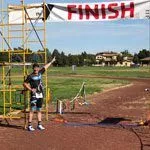Understanding Your 80/20 Cycling Plan
Be sure to read Intensity Guidelines for Cycling and Understanding Your TrainingPeaks.com Structured Workout Plan after reading this article.
A training plan is only as good as its execution. Even the best training plan won’t help you much if you don’t understand it. This document offers guidelines and tips to help you get the most out of the 80/20 triathlon cycling plans.
Anatomy of a Workout
Each workout has three basic elements. The first two are duration/distance (how long the workout is) and intensity (how fast the workout is). The third is structure, which is how the workout is divided into segments of various lengths and intensities.
The workout descriptions you see in the training schedules provide duration/distance, intensity, and structure information in a condensed format. Let’s look at a cycling example:
CAP5 (Aerobic Progression Ride)
5:00 in Zone 1
10:00 in Zone 2
2 x (3:00 in Zone X/1:00 in Zone 1)
2 x (4:00 in Zone 3/1:00 in Zone 1)
2 x (5:00 in Zone Y/1:00 in Zone 1)
10:00 in Zone 2
We chose this example because it has a fairly complex structure. Nevertheless, it’s not at all difficult to decode and follow. The workout has three segments: a warm-up, an interval set, and a cool-down.
“5:00 in Zone 1,” is part one warm-up segment. You’ll execute this part by cycling easily for 5 minutes at Zone 1 intensity.
“10:00 in Zone 2” is part two of the warm-up segment. You’ll execute this part by cycling easily for 10 minutes at Zone 2 intensity.
“2 x (3:00 in Zone X/1:00 in Zone 1)” is the first interval segment. Cycle for 3 minutes in Zone X, then slow down and cycle for 1 minute in Zone 1, and repeat this sequence a total of two times. The next two interval segments follow the same pattern, except that the hard efforts are both longer and more intense.
“10:00 in Zone 2” is the cool-down segment. You’ll execute it by cycling easily for 10 minutes at Zone 2 intensity.
There is an almost infinite variety of workout structures, but if you understand how to interpret and apply the example we just covered, you can do the same with any other workout.
Getting to Know Your Zones
Perhaps the trickiest part of executing the workouts that are prescribed in a training plan is training at the right intensity in each segment. You will find complete guidelines for using our Seven-zone intensity scale in our Intensity Guidelines. But simply reading these guidelines alone won’t enable you to fully master the skill of training in the right zones. A certain amount of experience is also required.
Don’t worry: It doesn’t take long to develop a feel for the various zones, so that, for example, when you start a 3-minute interval in Zone 3, you are able to settle into the right effort level even before your heart rate monitor, power meter, or GPS watch confirms that you’re in the correct zone. Here are some specific tips for mastering each individual zone:
Zone 1
Zone 1 is a very low intensity. Staying within it usually requires that you actively hold yourself back to a pace that’s slower than your natural pace. The common exception is when a Zone 1 segment follows a tiring high-intensity effort. The important thing to understand is that it’s almost impossible to go too slow when you’re aiming for Zone 1, whereas it’s very easy and all to common to go too fast.
Zone 2
Zone 2 is fairly broad. You might wonder, “Where exactly within this zone should I be?” As a general rule, we encourage triathletes to go by feel. If you feel strong, swim, ride, or run near the top end of Zone 2. If you feel tired or sluggish, go ahead and allow yourself to exercise near the bottom end.
Zone X
Zone X is the trap that most triathletes fall into, and avoiding it is one of the key objectives of the 80/20 training approach. Just easy enough to not be uncomfortable, yet just hard enough to make you think you’re getting a good workout, this lukewarm intensity offers minimal value in increasing fitness while generating fatigue that interferes with recovery and with performance in subsequent intense workouts. Avoiding Zone X allows you to go harder on the hard days and gain more fitness. For half and full Ironman athletes, Zone X is used sparingly in the Specific phase of training to prepare you for your event, as Zone X does overlap with race intensity for these longer distances.
Zone 3
Zone 3 corresponds to lactate threshold intensity and marks the beginning of "legitimate" moderate to high intensity. Thinking in “threshold” terms can help you find this zone and stay in it by feel. The feeling of swimming, riding, or running in Zone 3 is often described as “comfortably hard,” or as the fastest speed that still feels relaxed. When you perform a Zone 3 effort, imagine there’s a cliff edge in front of you that represents the feeling of strain that accompanies faster speeds. Always stay one or two steps back from that precipice when training in Zone 3.
Zone Y
While Zone Y is not as detrimental as Zone X, this narrow intensity gap simply isn’t targeted by any of the tried-and-true workout formats. It’s a little too fast for threshold workouts, which traditionally target Zone 3, and a little too slow for high-intensity interval workouts, which offer more fitness bang for your workout buck when done in Zones 4 and 5.
Zone 4
Mastering this zone is a matter of connecting the pace, power, and/or heart rate numbers that define the zone with what it feels like to train at that power, pace, or heart rate, so that you are able to reliably start each zone 4 effort at the right intensity. If you mess it up the first few times, either going too slow or too fast, don’t sweat it. In fact, getting it wrong today is the best way to get it right tomorrow.
Zone 5
Zone 5 is almost always used in interval workouts similar to the one given as an example earlier in this article. This intensity zone ranges from the highest speed you can sustain for a few minutes all the way to a full sprint. So how fast should you actually go in Zone 5 efforts?
Tailor your effort to the specific format of the workout. The rule of thumb here is to stay closer to the bottom end of Zone 5 when these efforts are longer and hew closer to the top end when the intervals are shorter. For example, if a workout asks you to run a bunch of 90-second intervals in Zone 5, you’ll want to control your pace so that you are able to run all of the intervals at the same speed without slowing down. But if a workout prescribes a set of 20-second intervals, you’ll want to do them as relaxed sprints.
When using heart rate to measure intensity, you'll soon discover that your BMP takes 1-2 minutes to "catch up." As a result, you'll often not reach the heart rate target during very brief Zone 4 or 5 intervals. Pace and Power are more reliable methods to measure those high intensities. This issue can also be resolved by using the 80/20 Run and Bike Zones Garmin App, where you can have both real-time HR and your custom 80/20 Pace or Power zones displayed on your device at the same time.
You may wonder why a seven-zone intensity scale such as ours tops out at Zone 5. The reason is that in the original version of the scale, Zone X and Zone Y were not explicitly named. Instead these zones existed only as gaps between Zones 2 and 3 and between Zones 3 and 4, respectively. The first gap was created to ensure that low-intensity exercise efforts did not accidentally bleed into moderate intensity and the second to encourage athletes to commit to either moderate or high intensity. Nevertheless, many athletes found the gaps confusing, so we modified the 80/20 intensity scale in a manner that eliminates gaps and the confusion they cause while preserving the distinction between untargeted zones (X and Y) and targeted zones (1-5).
Riding Indoors Vs. Outdoors, On-Road Vs. Off-Road
There are three basic venues for bike workouts: Indoors, outdoors on paved roads, and outdoors on gravel or dirt. Where you choose to do any individual bike workout should depend on the workout type and what you’re training for.
If you’re training for a Gran Fondo or road century event, we suggest you ride outdoors on paved roads at least once per week. The most important rides to do outdoors on paved roads are Endurance Rides. Interval workouts and other rides with a more complex structure are typically easiest to perform indoors, but they don’t have to be. An outdoor route where it’s easy to control your intensity is fine. If you enjoy riding on gravel or trails, it’s fine to do so occasionally even when you’re training for a road event. Just try to match up your off-road rides with workouts that are conducive to the terrain. For example, a mountainous and highly technical singletrack trail is probably not the best place for an Easy Ride.
If you’re training for a gravel race, we suggest you do ride outdoors on gravel or dirt at least once per week. The most important rides to do outdoors on gravel or dirt are Endurance Rides, but you’re welcome to do as many other types of rides on such routes as you can execute correctly. It’s okay to modify workouts a bit to fit the terrain. For example, if a given workout calls for five Zone 4 intervals lasting 2 minutes each with 3 minutes in Zone 1 between intervals, and you choose to perform the ride on a hilly trail route, you might want to complete the Zone 4 efforts on sections of trail that are conducive to riding at this intensity, even if this means they aren’t all separated by exactly 3 minutes.
If you’re training for a time trial or FTP test, you’ll want to do most of your key rides (i.e., rides featuring efforts in Zone X and above) in the same venue as the event itself. So, if you’re training for a road time trial, be sure to do most of these workouts on the road, whereas if you’re training for an indoor time trial or FTP test, choose the same location for the majority of your key workouts.
Cadence
Note that none of the workouts included in our cycling plans feature prescribed cadences. The main reason is that optimal cadence is not the same for all cyclists. A prescribed cadence that's perfect for some will be either too fast or two slow for others. This doesn’t mean you should ignore your cadence, however. For more information about how to approach cadence in your bike training, read this article by Coach Matt.
Cross-training
Some of our cycling plans contain optional cross-training sessions. It is recommended that you do these workouts consistently if you do them at all. Only when done consistently will they make a meaningful impact on your fitness. It is also recommended that you be consistent in your activity choice. For example, if you choose yoga for some of them, it's best to do yoga for most of them, so that the benefits accumulate. It's best to choose an activity that isn't too strenuous. In addition to yoga, walking, hiking, easy swimming, and Pilates are good options. You may also do a gentle, active-recovery type of bike ride.
It's okay to replace some of your scheduled Easy Rides with alternative aerobic activities as well. This is a good option if, for example, you're a runner or duathlete who is currently focused on cycling but wants to maintain a baseline of run fitness. In this case, you might want to replace two Easy Rides per week with Foundation runs. Again, you'll want to be consistent with this practice if you choose to implement it.
Perfection Is Overrated
While it’s important to execute workouts as they were intended to be done, it is not necessary that you execute every workout perfectly, and you shouldn’t beat yourself up when a given workout is not done to the letter. If the 2-hour ride on your schedule for today ends up being a 1:57:30, no big deal.
There’s a well-known story about a legendary running coach who always had his athletes run 187-meter hill repetitions. Another coach who admired this legendary coach emailed him to ask about this very precise distance. “Why 187 meters?” he asked, assuming there must be some deep physiological rationale for it. But the legendary coach came back with this answer: “Why 187 meters? Because that’s how long the hill closest to our training camp is!”
Keep this story in mind as you execute your 80/20 training plan. As with horseshoes and hand grenades, close is good enough.
The Importance of Listening to Your Body
There are some times when executing the workouts in your training plan to the very letter is a bad idea. For example, if you get three intervals into a nine-interval workout and you feel absolutely terrible, you should probably stop, or replace the remaining intervals with an easy jog. A helpful guideline to follow is this: If your interval pace or power is >3% less than it was in the previous interval, terminate the interval set and complete the remaining time in Zone 1 or 2. Similarly, if you wake up one morning with a really sore foot that hurts even to walk on, you should not run that day.
A training plan is really an attempt to predict the future. The many workouts that comprise a training plan represent what you should do if everything goes perfectly—that is, if there are no days when you feel really lousy or have an alarming sore spot. But things seldom go perfectly all the way through a training plan. It’s important that you listen to your body at every step of the process and make adjustments as necessary based on what your body is telling you.












































































